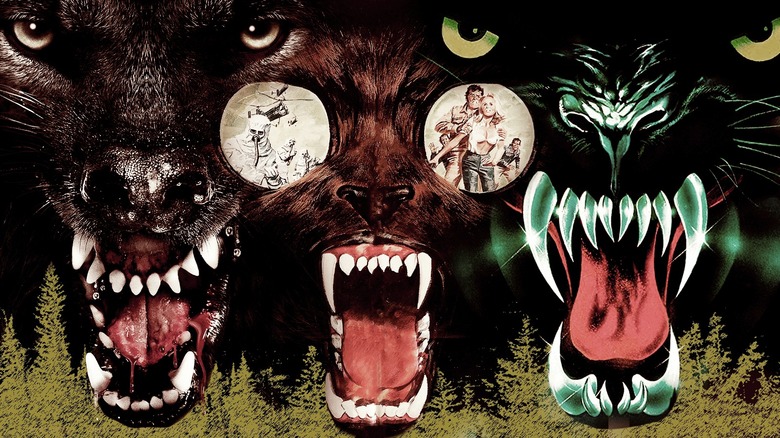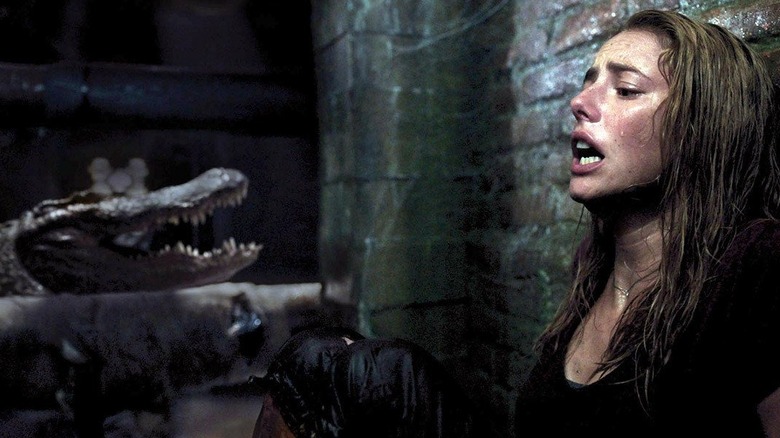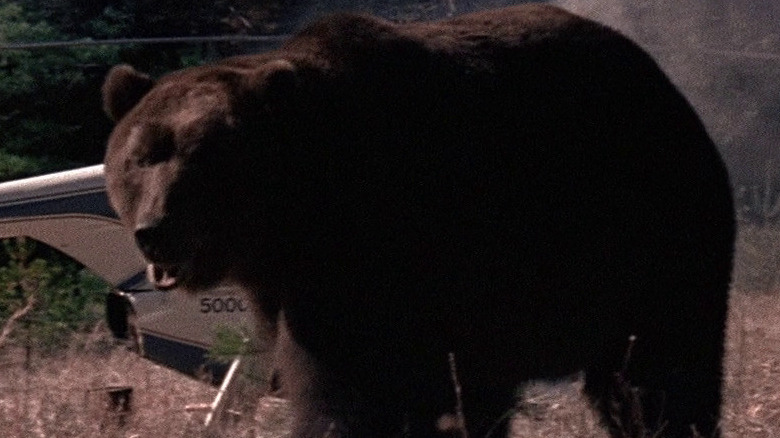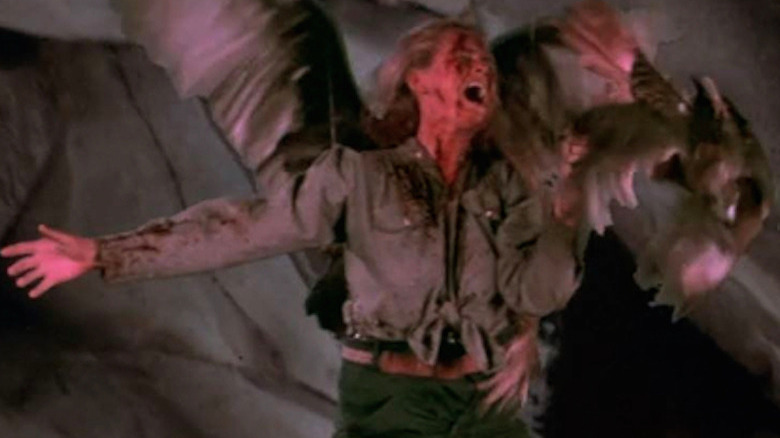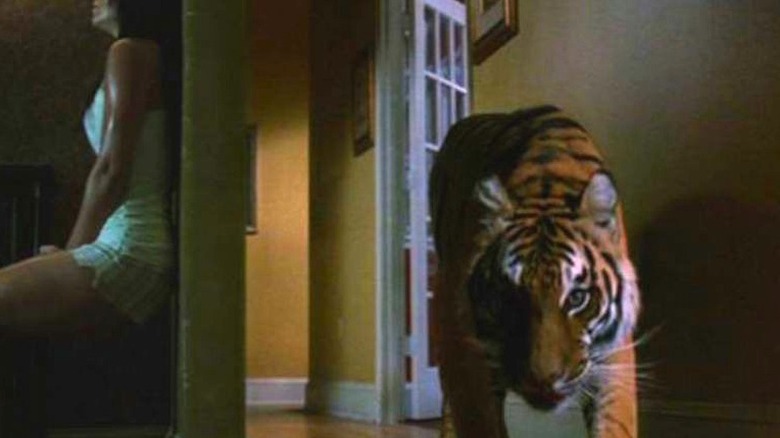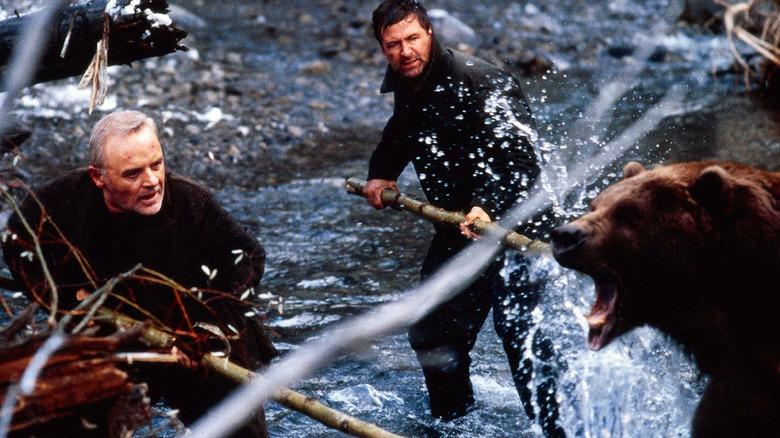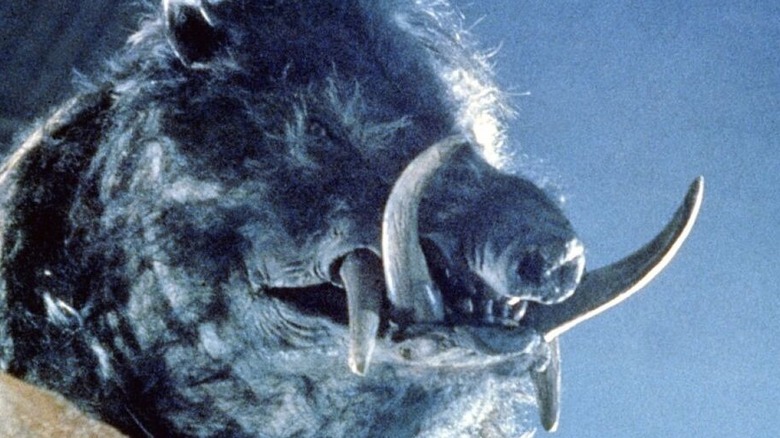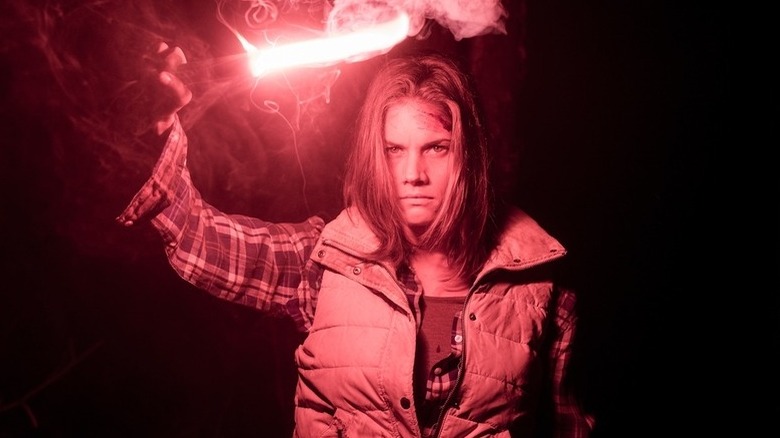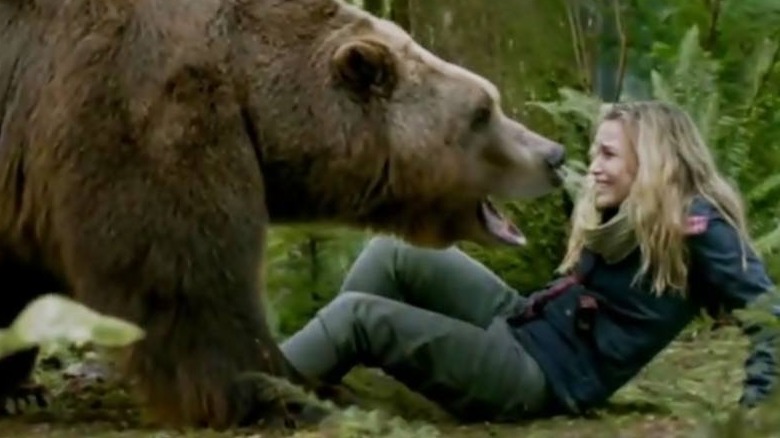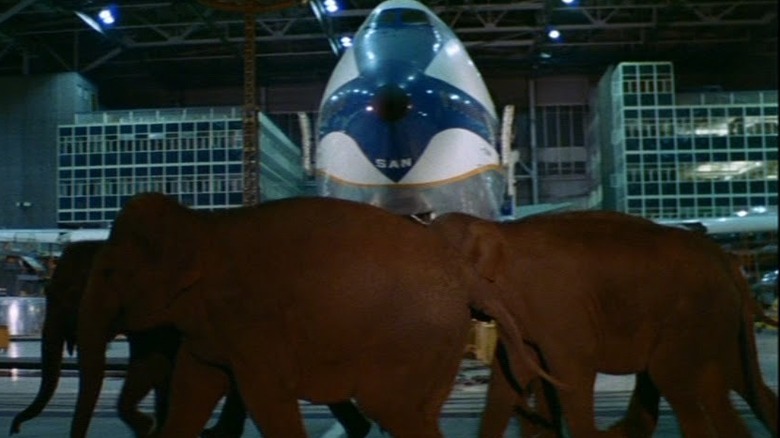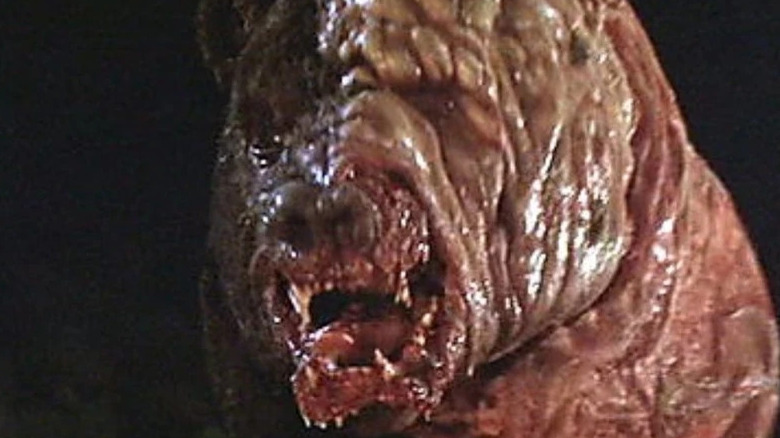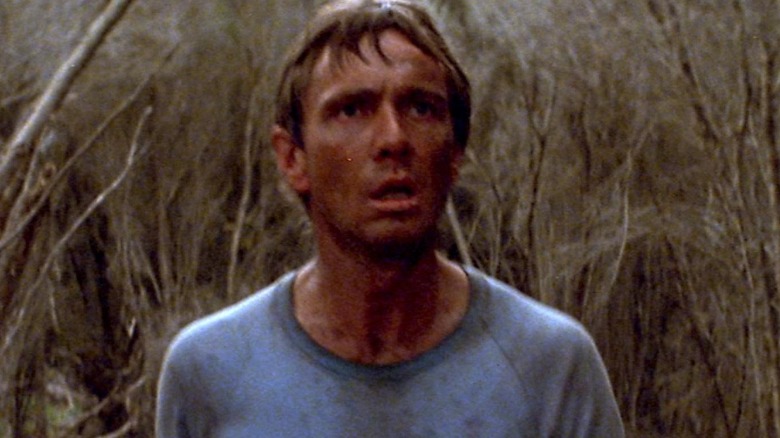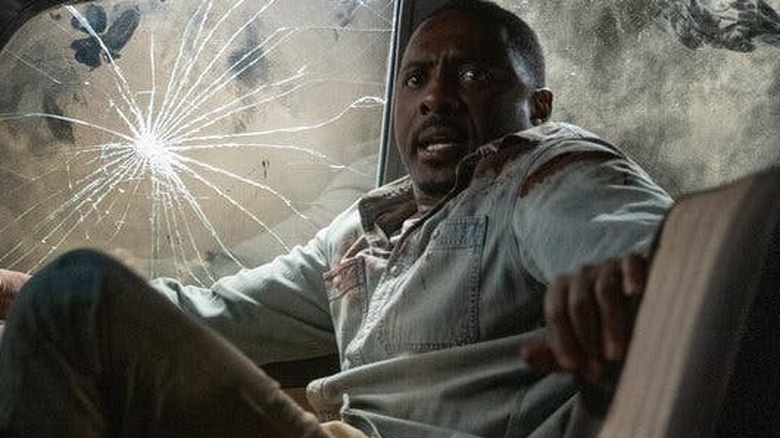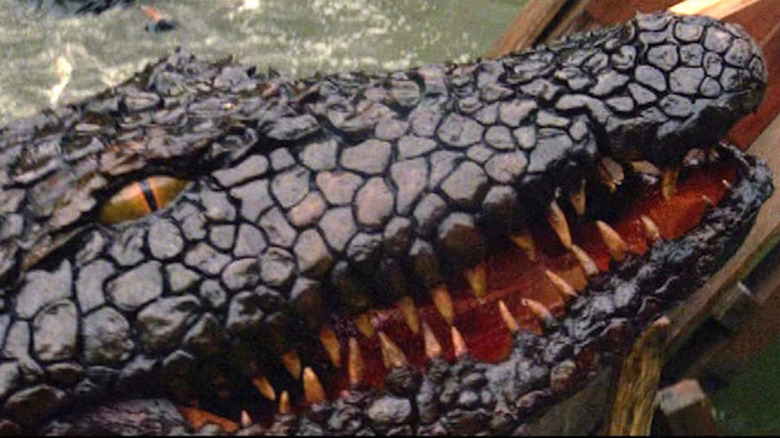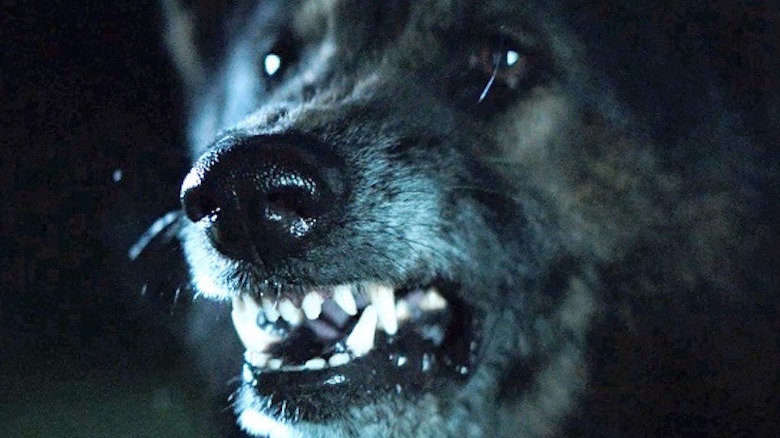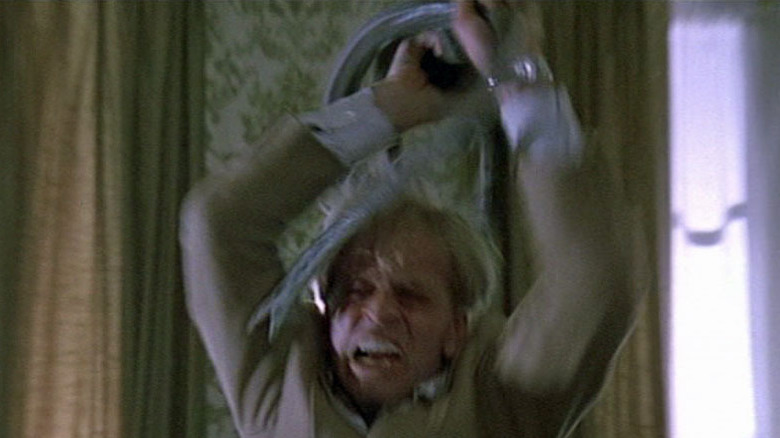15 Best Animal Attack Movies Like Cocaine Bear Fans Should Check Out
Elizabeth Banks' feature "Cocaine Bear" defies description in many ways: It's a thriller based on a real-life case that frequently veers into both violent action and comedy, but it also fits neatly into a long-running subgenre of suspense and horror referred to informally as either animal attack or nature-revenge films. As the labels suggest, the movies anchor themselves around wildlife — typically on the large, powerful, and/or carnivorous side — that take out their aggressions on humanity, typically for some egregious violation of their habitats, such as pollution, overdevelopment, or just plain bad behavior. The subgenre is far-ranging in scope and includes everything from studio features and blockbusters like "Jaws" and "Arachnophobia" to offbeat indies like "Phase IV," cult titles like "Kingdom of the Spiders," and the absurd "Sharknado" series.
If "Cocaine Bear" whets your appetite for more animal attack flicks, here are a few more movies that feature a zoo's worth of animals laying down the law against two-legged ruffians. Like the genre itself, the list includes box office hits, sleepers, and a handful of so-bad-it's-good titles, all delivering intense, funny, or grisly takes on the subgenre. And in the interest of taming what could be an unreasonably huge selection, we've limited the animals here to mammals and reptiles, so you won't find sharks, piranhas, killer bees, or soldier ants here.
Crawl (2019)
Having proven that he could turn out grindhouse-styled thrills with his remakes of "The Hills Have Eyes" and "Piranha," viewers probably saw director Alejandra Aja's 2019 feature "Crawl" as more of the same trashy fun. What they got instead was a taut horror-thriller co-produced by Sam Raimi that in its best moments delivered gory creature carnage, well-crafted characters, and heart-stopping suspense set pieces that seemed to be missing from Aja's other films after his blood-soaked 2003 debut with "High Tension."
British actress Kaya Scodelario ("The Maze Runner") is top-billed as a college student and swimming champ who returns to her Florida home to check on her father as a Category 5 hurricane bears down on the state. What she finds is her dad, Dave (Barry Pepper), gravely injured, the house full of water, and the property patrolled by a congregation of hungry alligators set loose by the storm. Aja doesn't skimp on the gator-vs-human action — the fate of a trio of looters in a flooded convenience store is a highlight — but also makes sufficient room for Scodelario and Pepper to overcome long-standing grudges and work together as last-minute motivation. A sizable hit on a minor budget (with a Serbian soundstage standing in for the Sunshine State), "Crawl" shows that animal attack movies can be more than just a catalog of grisly thrills.
Grizzly (1976)
Kentucky-based filmmaker William Girdler was behind the camera for one most entertaining animal attack movies of the 1970s: "Grizzly," a bear-gone-berserk thriller that borrowed much of its plotline from the biggest and baddest nature horror pic of the decade, "Jaws." Co-producers and co-writers Harvey Flaxman and David Sheldon essentially transpose the major bullet points of Spielberg's film to a national park (actually filmed in Georgia), where a living fossil — a 15-foot prehistoric bear — is dining on campers. Park ranger Christopher George (the film's faux Brody) teams with helicopter pilot Andrew Prine (the ersatz Quint) and naturalist Richard Jaeckel (substitute Hooper) to bring down the big bear, which ultimately involves a bazooka.
"Grizzly" is perfectly happy to offer up carbons of the entire "Jaws" highlight reel — Prine tells an ursine version of the U.S.S. Indianapolis story, park supervisor Joe Dorsey plays the naysaying Mayor Vaughn card, and a gaggle of amateur bear hunters and even an unclad swimmer all come to bad ends. And as Girdler can't ape Spielberg's filmmaking skills, he offers the next best thing for exploitation fans: gallons of gore, including a little kid who suffers a fatal bear hug. However, the gross-out element in these scenes is largely undone by obvious guy-in-a-bear-suit shots and the bear itself, a chubby Kodiak who looks more adorable than menacing. However, even in its worst moments, "Grizzly" towers over its atrocious sequel, "Grizzly II: The Revenge," an ultra-low-budget mess filmed in 1983 which employed then-unknowns George Clooney, Laura Dern, and Charlie Sheen, but went unreleased (for good reason) until 2020.
Day of the Animals (1977)
Flush with a financial windfall from "Grizzly," director William Girdler and producer Edward L. Montoro naturally considered a follow-up: If one crazed animal brought out ticket buyers, might the response to a whole forest of rampaging critters be even greater? Unfortunately, "Day of the Animals" was no "Grizzly" at the box office, netting just $2.8 million (to "Grizzly's" $39 million), but the film itself was just as gonzo as its predecessor, if not more so, in regard to entertaining animal attack mayhem.
Girdler brought back Christopher George and Richard Jaeckel, as well as adding several more performers to the dinner menu for his killer woodland creatures. George's wife, Lynda Day George, co-stars with Leslie Nielsen, TV vet Michael Ansara, and to underscore the film's unspoken connection to "Jaws," Susan Backlinie, who played the doomed Chrissie Watkins in the Spielberg film, was on hand to again meet an awful fate (this time, it's a one-two punch of wolves and hawks).
The premise is just as loopy as "Grizzly": A hole in the ozone layer drives animals in Northern California to attack humans, which is poor timing for Christopher George and a crew of hikers. Their numbers are quickly decimated by a small army of angry beasts, from mountain lions and snakes to wild dogs and even rats. The attacks are very well orchestrated (by animal trainer Monty Cox with Backlinie's reported help) and appear to involve real animals as opposed to the ratty fur suit in "Grizzly." This suit (or one like it) does turn up in the film's show-stopper sequence, though, in which Nielsen — playing a toxic macho type — loses his marbles and strips to the waist to grapple with an enormous grizzly.
Burning Bright (2010)
"Crawl" shares more than a few DNA strands with 2010's "Burning Bright," an equally gripping thriller in which another resourceful young woman is trapped in a house with a man-eater because of a natural disaster. Here, the young woman is Briana Evigan ("Step Up 2: The Streets"), who has personal fires to put out on multiple levels before she ever finds herself hunkered down in a house with a tiger inside and a hurricane on the horizon.
She wants to return to college and find proper care for her autistic brother ("Ozark's" Charlie Tahan), but money is tight thanks to her stepfather (Garrett Dillahunt), who's blown their money on a tiger for a planned safari park. But as Evigan soon finds out, her stepdad is more monster than deadbeat, as he's found a solution for both his tiger and stepchildren problems by sealing them all together in their house as the hurricane bears down on them.
"Burning Bright" has a complex set-up, but once the kids and the tiger are in the house, it boils down to a survival game, with Evigan trying to keep herself and her brother alive and the tiger doing its best to achieve the opposite result. Director Carlos Brooks – who has remained off the radar since this film's release in 2010 — shows exceptional skill at delivering breathless suspense set pieces on a lean budget. He's also aided by a smart script by Christine Coyle Johnson and Julie Prendville Roux, making Evigan a flawed but realistic character who survives by wits and guts.
The Edge (1997)
"Burning Bright" makes a solid case for a secondary thriller subgenre within the nature revenge category that might be called animal attack noir. The 1997 film "The Edge" also might find purchase there as well: While the core of its action revolves around stars Anthony Hopkins and Alec Baldwin's fight against a massive Kodiak bear while stranded in the Alaskan wilds, the script by David Mamet adds layers of conflict and deception between the two men — a billionaire and a photographer, respectively, who are linked by their mutual desire for Hopkins' model wife (Elle Macpherson) — that lends greater depth and suspense to the material.
Stripped down to its basic premise, both Hopkins and Baldwin's characters are looking to survive their ordeal but also make sure that the other one does not walk out of the woods at the end of the picture. The bear — played by Bart the Bear, a superstar in the performing animal world who also appeared in "Legends of the Fall" with Hopkins — operates primarily as a motivating factor for both men to bury the hatchet and work together. It's a neat reversal of most animal attack movies, which use their killer critters as pure suspense engines.
Razorback (1984)
Wild pigs have not enjoyed the same level of stardom through animal attack movies as other species, such as sharks, snakes, or wolves. Maybe it's due to the fact that audiences seem to prefer their movie pigs either cute ("Charlotte's Web") or wise ("Babe"), though a more likely reason is that the majority of wild pig movies are lousy (see "Chaw," "Pig Hunt," and "Hogzilla," if you don't believe us). However, the pigs do have one solid title in the animal attack genre: The 1984 Australian film "Razorback," which pits American actor Gregory Harrison against a colossal wild boar eating its way through the population of the Outback.
Directed by Russell Mulcahy two years before his Hollywood debut with "Highlander," "Razorback" stands apart from the rest of the horror hog scene (and most other low-budget animal attack movies) by virtue of three elements. It boasts a clever and surprising script by Australian horror specialist Everett De Roche, who isn't afraid to kill off sympathetic characters or depict his countrymen in unflattering lights. There are also spectacular visuals courtesy of cinematographer Dean Semler ("The Road Warrior"), who turns the film's locations — the more remote corners of New South Wales – into nightmare territory where a boar the size of a garbage truck might thrive. The razorback itself is both an impressive practical effect and a memorable movie monster, a mindless, merciless engine of destruction that far surpasses the CGI monster hogs that followed in its wake.
Backcountry (2014)
The easiest way to draw an audience to an animal attack movie is to focus on the violence that can happen when humans interact with wild animals. Promise enough scenes of bears or sharks or snakes attacking people and you'll sell some tickets. Adam McDonald's 2014 Canadian indie "Backcountry" has one such moment, but it's just a small part of a more nuanced and ultimately more terrifying drama that's also based on a harrowing true story.
There's a bear in "Backcountry" — a very hungry black bear that makes life miserable for Missy Peregrym ("The FBI") and Jeff Roop — but the couple was already down that road before they ever set out on a backpacking trip in the Canadian woods. Roop is a know-it-all hipster so determined to have an "authentic experience" that he packs lots of expensive gear but forgets a map, compass, or even enough water for the trip, while Peregrym is a tightly wound lawyer who realizes far too late that her all-important cell phone has been left at the start of their journey.
Drop a pair of characters like these into a tightly edited and carefully composed film that draws tension from small moments, not big scares, and you've got an effective thriller. But sharpen the focus on those characters more carefully, allowing the audience to connect with them as their situation goes from bad to worse, and you've got an even more memorable experience. "Backcountry" may lack star power and big-budget effects, but it lands a harder punch (claw?) than many studio efforts in the same vein.
Into the Grizzly Maze (2015)
"Into the Grizzly Maze" borrows its title from the 2005 book "The Grizzly Maze," which details the short life of amateur bear researcher Timothy Treadwell, whose demise was also the subject of Werner Herzog's documentary "Grizzly Man." The similarities end there: "Into the Grizzly Maze" is essentially "Jaws" with paws, exploring the hunt for a monster bear (played by celebrity grizzly Bart the Bear 2) that devours loggers and poachers in a stretch of dense Alaskan wilderness. James Marsden and Thomas Jane brood up a storm as estranged brothers charged with tracking down the beast, while Piper Perabo and Michaela McManus are in constant peril as their significant others. Billy Bob Thornton plays the film's version of Quint, a hunter who expounds at length on the bear's smarts and appetite.
Guy Moshe and Jack Reher's script hits all the well-worn tropes to qualify as bearsploitation — a super-powered animal, lots of gory kills, and endless wondering about the bear over the remains of its victims — which leaves the actors to give "Into the Grizzly Maze" some substance. They're mostly successful, and David Hackl ("Saw V" and "VI") keeps the material suspenseful and focused when the plot threads and abundant characters threaten to leave audiences as lost as the main characters.
Wild Beasts (1984)
The 1984 Italian exploitation film "Wild Beasts" thinks you're the worst. But before you get too upset, understand that it also holds the rest of humanity in low regard. Because somehow, you and the rest of the human race are responsible for PCP entering the water system in Frankfurt, Germany, causing the animals in a zoo to run amuck and attack thoughtless people just like you. So if you're astonished and appalled by scenes showing a polar bear attacking a kids' ballet class or smooching lovers eaten alive by rats, well, you only have yourself to blame.
"Wild Beasts" was directed by Franco Prosperi, who, with Gualteri Jacopetti, created "Mondo Cane," a cynical look at "strange practices" around the world that somehow earned an Oscar nomination (for its title song, "More") in 1962. It in turn generated a wave of increasingly crass "mondo" documentaries in the late 1960s and 1970s, each making pompous pronouncements on civilization's decline while hawking cheap thrills and flashes of real violence, often involving animals.
Prosperi borrowed that mix of heavy moralization and geek show antics for "Wild Beasts," which remains his sole non-documentary effort. The animal attack scenes are a mix of visual effects and sheer cinematic chutzpah — the dance studio attack seems to put little Louisa Lloyd right in the path of a real, rampaging polar bear — and the final plot twist is at once shocking and ridiculous. But scenes that involve animal cruelty are reprehensible, so viewers are advised to approach "Wild Beasts" with caution.
Prophecy (1979)
Perhaps a giant bear does not offer the degree of horror movie thrills to which you have become accustomed. Consider, then, 1979's "Prophecy," which offers instead a wonderfully absurd ten-foot bear mutated and maddened by chemicals released by a logging operation into a pond in Maine. The monster bear — portrayed at various times by 7'2" actor Kevin Peter Hall and various puppeteers — lays waste to loggers, and in one memorable moment, a kid in a sleeping bag, before EPA scientist Robert Foxworth ("Falcon Crest") does away with her and her gruesome cubs in the finale.
"Prophecy" was directed by Emmy-winning filmmaker John Frankenheimer, whose wildly diverse credits include some of the best ("The Manchurian Candidate") and worst ("The Island of Dr. Moreau") films of the last half-century. It's definitely part and parcel with the socially conscious themes that recur throughout his work — corporate destruction of the environment is hammered repeatedly in its running time — but any effective statement on that subject is totally undone by the special effects, which include the appallingly shoddy suit and puppet for the monster mama bear itself and a host of mutated woodland friends, including a gonzo raccoon, a rubbery tadpole the size of a loaf of bread, and a salmon that gulps down an entire duck.
Long Weekend (1978)
Most animal attack movies are extended metaphors for the natural world fighting back against humanity, and the 1978 Australian thriller "Long Weekend" is no exception. Director Colin Eggleston and writer Everett De Roche ("Razorback") pit a combative couple (Jack Hargreaves and Briony Behets) against the flora and fauna of their vacation destination on a remote stretch of beach. The couple are depicted as the worst sort of environmental abusers: They tromp through private property, carelessly kill a few animals, and prove themselves to be thoughtless, self-centered boors (in matching tracksuits, no less).
Naturally, the human cast members were poised to take abuse through ferocious attacks. And while Hargreaves and Behets' characters earn their share of lumps from various creatures — an eagle buzzes their campsite, a Tasmanian Devil snarls at them — "Long Weekend" takes a more surreal approach to the idea that makes for a less visceral but more haunting experience.
The animal attacks appear to be part of a larger campaign by unseen forces (or perhaps pure coincidence) that conspire to drive the couple slowly mad before pushing them toward their doom. The beach itself doesn't appear to actually exist — none of the locals have heard of it — and despite endless treks, the couple seems unable to ever leave it. And then there's the dugong, which Hargreaves' character kills, believing it to be a shark, but it returns time and again, watching them on the shore. Just desserts are served by the film's conclusion, but the couple's fate lacks the queasy moral victory in most animal attack movies. It's far too creepy for easy answers. There's a remake, titled "Nature's Grave," but stick with the original.
Beast (2022)
The 2022 big cat thriller "Beast' is saddled with a paper-thin script overflowing with lightweight character sketches and well-worn platitudes about protecting animals (even the ones that want to eat us). But it also has Idris Elba as its hero, a scientist and widowed father who uses his heart and intellect to protect his daughters from a rogue lion who might be charitably described as a four-legged killing machine. Elba's immense likability grounds the film in human emotion when it threatens to unspool in jump scares and cartoonish plotting.
Elba is in South Africa to reconnect with his daughters after the death of their mother. The girls (Iyana Halley and Leah Sava Jeffries) are none too pleased with him, since they blame him for abandoning their mom while she was dying of cancer. The appearance of the lion — whose murderous impulses are due to the death of its pride at the hands of poachers — gives Elba a chance to play the good guy, and director Baltasar Kormakur gives him plenty of heart-in-the-throat scenarios in which to prove his mettle. The script takes that arrangement to the furthest limits, which eventually has the lion acting in ways that seem more "evil genius" than "angered animal." But it's Elba that brings the material back to its core — a man trying to save his family — time and again. He's no superhero: Rather, he uses his scientific background to determine the cause of the lion's behavior and the best way to stop its rampage. When that fails, he falls back on a couple of well-placed punches, but unlike many movie protagonists, those are his last resort.
Killer Crocodile (1989)
Radioactive waste dumped into a tropical paradise, you say? Sounds like an opportunity for nature to strike back against polluters, and this time, it's a "Killer Crocodile" that's handing out the fines (read: eating people). The bad guys, most of whom find themselves on the wrong side of the titular monster's mouth, are sleazy industrialists pouring factory waste into the waters of the Dominican Republic, aided by a judge (Hollywood star Van Johnson) who's on their payroll. The good guys — a faceless crew of twenty-somethings led by the son of "Flamingo Kid" star Richard Crenna and '80s B-movie actress Sherrie Rose — discover the illegal dumping, but somehow get framed for a string of deaths that were clearly carried out by an enormous animal and not a bunch of kids with New Wave hair.
And the monster? Just your average giant crocodile, made exponentially angrier and hungrier due to the befouling of its habitat, and which spares no one, including a little kid and a cute dog, from being chewed up. The croc is actually the highlight of this Italian-made picture, and though stiff and cumbersome by modern CGI standards, makeup effects artist Giannetto di Rossi's design is menacing and (most importantly) doesn't look ridiculous when actors flail around in its mouth. Di Rossi created grisly effects for numerous Italian horror films (as well as for "Rambo III," "High Tension," and David Lynch's "Dune"), including Lucio Fulci's "Zombie," which was produced by "Killer Crocodile's" director, Fabrizio De Angelis. Di Rossi stepped into the director's chair for the 1990 sequel, which is loaded with flashbacks to the first film while also upping the iconoclastic antics by adding a nun to the croc's diet.
The Pack (2015)
Not to be confused with the 1977 dog attack film of the same name — which, truth be told, might make an acceptable runner-up on this list — the 2015 "Pack" is an Australian film about a rural family whose farm is under siege by a pack of ferocious wild dogs. The family is already treading water long before the pack arrives — the farm is failing and faces foreclosure by a local bank, which has pulled the family apart — but once the dogs make their presence known, "The Pack" becomes a game of survival, as its human characters attempt to unite in order to outwit a larger, faster, and in many ways, more strategic enemy.
Critical response to "The Pack" was mixed, with most reviewers citing the lightweight character construction as its chief failing. However, the film has plenty of visual polish, and first-time director Nick Robertson shows a steady hand in building tension, with the dogs' constant shadowy presence — even inside the family's house — raising the most chills before the final all-out attack.
Venom (1981)
Director Tobe Hooper (of the original "Texas Chain Saw Massacre") exited this 1981 British thriller about a poisonous snake, and according to Piers Haggard, who replaced him, it sounds like he was spared a lot of headaches. In a 2003 interview with Fangoria (via MJSimpson-Films), Haggard said that filming was complicated by stars Klaus Kinski and Oliver Reed — two actors not exactly known for their polite on-set behavior — who aggravated each other with their boorish antics.
In addition to the backstage drama, "Venom" also suffers from silly plot problems: Should we believe that young Lance Holcomb would accidentally receive a black mamba, one of the deadliest creatures on Earth, instead of a harmless pet snake? And is it feasible that said snake would get free within seconds of entering Holcomb's house and immediately stalk the inhabitants with "Jaws"-like intensity? Or that all this snake-on-the-loose business would happen on the same day that Holcomb and his grandfather (American actor Sterling Hayden) are held captive by Kinski, Oliver Reed, and Susan George, who also work as Hayden's chauffeur and maid, respectively.
You can sweat those details until the final credits, or you can dig into the real reason to watch "Venom": the mamba's horrifying attacks. George suffers an ugly and protracted demise, but it's Reed who takes top honors in terms of ghastly ways to go. Rendered immobile from a gunshot wound, Reed is forced to watch the snake slither slowly up his trouser leg until ... well, suffice it to say that every possible nightmare scenario involving a snake that you've ever considered pales in comparison.
